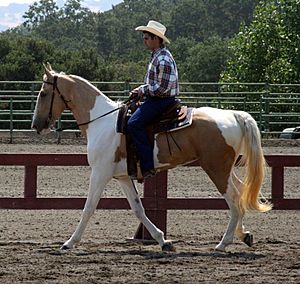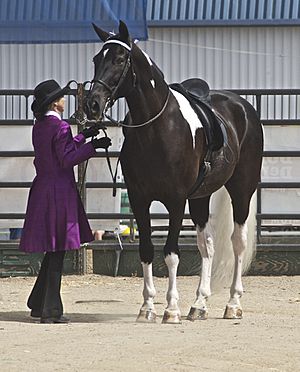Spotted Saddle Horse facts for kids

Spotted Saddle Horse under saddle
|
|
| Distinguishing features | Pinto coloration, ambling gait |
|---|---|
| Alternative names | SSH |
| Country of origin | United States |
| Breed standards | |
| Spotted Saddle Horse Breeders' and Exhibitors' Association | Breed standards |
| National Spotted Saddle Horse Association | Breed standards |
| Horse (Equus ferus caballus) | |
The Spotted Saddle Horse is a special horse breed from the United States. These horses were created by mixing Spanish-American pinto ponies with other smooth-gaited horse breeds, like the Tennessee Walking Horse. The goal was to make a colorful horse that moves smoothly.
Spotted Saddle Horses are great for horse shows and for fun rides on trails. There are two main groups that register these horses, one started in 1979 and another in 1985. They both have similar rules for registering horses. Spotted Saddle Horses are always pinto in color. This means they have patches of white on their coats. Even if a foal is born without spots, it can still be registered for tracking its family tree. These horses always perform a special smooth gait called an ambling gait, instead of a trot. They also do the usual walk and canter, just like other horse breeds.
Contents
History of the Spotted Saddle Horse
The Spotted Saddle Horse first came from small, spotted ponies with a smooth gait. These ponies had Spanish ancestors. Later, they were bred with bigger American horses like the Morgan and Standardbred. This helped them grow larger while keeping their unique colors and smooth way of moving.
After the American Civil War, more gaited horse breeds were added to their family tree. These included the Tennessee Walking Horse, Missouri Fox Trotter, Paso Fino, and Peruvian Paso. Even Mustangs from the American West were part of their history. These horses were first developed in central Tennessee. People carefully bred them to have pinto colors. They were used for everyday riding and for exploring trails.
There are two main groups that keep track of Spotted Saddle Horses. In 1979, the National Spotted Saddle Horse Association (NSSHA) started in Murfreesboro, Tennessee. This group works to promote naturally smooth-gaited horses with pinto colors. The NSSHA is very strict about preventing cruel training methods. They do not allow practices that could hurt horses, like "soring." Soring is when people try to make a horse lift its feet higher by causing pain. This is against the law, according to the Horse Protection Act of 1970. The NSSHA also bans special devices or heavy shoes that might hide abuse.
In 1985, the Spotted Saddle Horse Breeders' and Exhibitors' Association (SSHBEA) was formed in Shelbyville, Tennessee. This group also works to protect horses. If rules are broken at their shows, horses can be disqualified. Today, you can see Spotted Saddle Horses at many horse shows. They are also still very popular for fun rides and trail adventures.
What Spotted Saddle Horses Look Like
Spotted Saddle Horses are light horses used for riding. They usually stand about 14.3 to 16 hands high. This means they are about 59 to 64 inches tall at the shoulder. They weigh between 900 and 1,100 pounds. The NSSHA will register horses that are a bit shorter, but they prefer taller ones.
Their heads are neat and refined. Their faces can be straight or slightly curved outwards. They have strong, slightly arched necks. Their shoulders are long and sloped, leading to a muscular chest. Their backs are short, and their hindquarters are strong and wide. The back part of their body, called the croup, slopes gently and is rounded. Their tails are set high. A perfect Spotted Saddle Horse looks like a slightly smaller, stronger Tennessee Walking Horse.
All Spotted Saddle Horses must have pinto coloring. This means they have white spots on any base color, like black, brown, or chestnut. The two most common patterns are called overo and tobiano. The amount of white spots can be just a little or almost cover the whole horse.
To be registered with the NSSHA, a Spotted Saddle Horse must have pinto coloring and perform an ambling gait. They cannot trot. As long as they meet these two rules, they can have any horse breeds in their family tree. Even if they are already registered as other breeds, like Racking Horses or Missouri Fox Trotters, they can still be registered with the NSSHA. If a foal is born without spots but has registered parents, it can be listed for "identification." This helps track its family, so any spotted foals it has will have documented parents.
The rules for the SSHBEA are similar for color and gait. They also allow "identification-only" registration for solid-colored foals. However, the SSHBEA is a bit stricter. For a foal to be registered with the SSHBEA, at least one of its parents must already be registered with them.
How Spotted Saddle Horses Move
The Spotted Saddle Horse is known as a "gaited" breed. This means they have a special smooth, intermediate-speed gait instead of a trot.
- Flat Walk: This is a regular four-beat walk, also called a show walk. Horses move at about 4 to 8 miles per hour.
- Show Gait: This is also a four-beat gait, similar to the flat walk but much faster. Horses can go from 10 to 20 miles per hour. This gait is very smooth for the rider.
- Canter: This is a three-beat gait that all horse breeds can do.
Some Spotted Saddle Horses can also perform other smooth gaits. These include the rack, stepping pace, fox-trot, or single-foot. All of these are intermediate gaits, meaning they are faster than a walk but slower than a gallop. They are different from each other based on how the horse's feet touch the ground.
See also
 In Spanish: Caballo de silla manchado para niños
In Spanish: Caballo de silla manchado para niños



